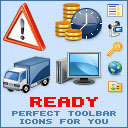


|
| ||||||||
|
|
Search Icons Icon |
|
Image sizes: 256x256, 48x48, 32x32, 24x24, 20x20, 16x16
File formats: BMP, GIF, PNG, ICO
Which web-site is stylish?
The stylish web-site is one where each page of your publication has a distinct identity to the entire web-site, one that is easy to navigate and search for information does not entail the danger of getting lost and lose time, one that has loading time of less than a minute.Stylishness web-site is achieved by several methods. Can distinguish the following elements involved in creating the style:
* Font - within the publication it should have the same characteristics - such as a headset (the mark), size (height), color. * Paragraph - it is desirable that prevailed in any one of the types of alignment on the page, for example, this publication is indented from the left edge and aligned to the left. * Color scheme web-site - it begins with the choice of three colors of the pages that are used to represent plain text, links and visited links. All these parameters are specified in the tag . Here, for example, shows a line specifying the color on these pages:
The color scheme must be repeated on all pages of the publication, it will create a visitor's sense of connectedness site. Color options try to choose a way that, on the one hand, the reader will see that this link, on the other hand, it would not prevent him from reading the main text. With regard to options, there are two useful observations: first - as if you do not like the colors of links and visited links the same (without good reason), try to overcome themselves and to give them a little different, this just make the color of visited links is a little darker; and the second - so happened that the underlined text in the Web represents a link, so the temptation to use extortion and underlined text in the publication, use another method selection. You know that is very unpleasant, if, say, your hand is stretched to the link to read the details, and a mouse on it zero attention. * Graphic design of the site - first, it must fit into the overall color scheme, and secondly, you should consider the overall concept of graphic design. All graphic elements can be divided into two broad classes: drawing and photorealistic. Try not to confuse these two types of registration. In addition, if you use the site photographs as illustrations, then spray them before use - make, if necessary, tone and color correction, cropping, select the approximate size of the photographs in publications, find a way to process the edge of the photo. And then use this design for the entire publication. I always write an explanation to the photos in the parameter ALT tag IMG - this will be perceived as a photo caption and, moreover, will relieve the user from standby in case he was not interested in this page. * Navigation through the site - it does not give the visitor get lost in the wilds of your site. Always leave the visitor the opportunity to go to the main page of the publication. Also, do not forget that many people get to your pages through search engines, ie not on the first page, and a good site should allow the reader to go to the first page, simply put, duplicate the navigation system on all pages, or make sure that they at least had a transition to the main page. If you do a navigation bar graphic means, then be sure to make her a copy of the text and put it somewhere below (the text in any case loads faster graphics).
Copyright © 2006-2022 Aha-Soft. All rights reserved.
|
